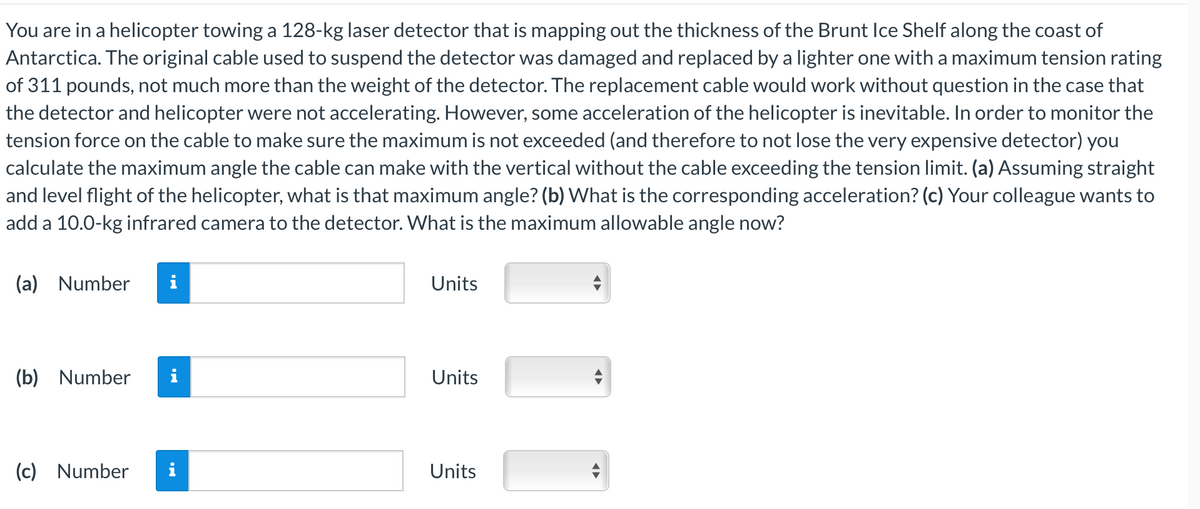You are in a helicopter towing a 128-kg laser detector that is mapping out the thickness of the Brunt Ice Shelf along the coast of Antarctica. The original cable used to suspend the detector was damaged and replaced by a lighter one with a maximum tension rating of 311 pounds, not much more than the weight of the detector. The replacement cable would work without question in the case that the detector and helicopter were not accelerating. However, some acceleration of the helicopter is inevitable. In order to monitor the tension force on the cable to make sure the maximum is not exceeded (and therefore to not lose the very expensive detector) you calculate the maximum angle the cable can make with the vertical without the cable exceeding the tension limit. (a) Assuming straight and level flight of the helicopter, what is that maximum angle? (b) What is the corresponding acceleration? (c) Your colleague wants to add a 10.0-kg infrared camera to the detector. What is the maximum allowable angle now? (a) Number i (b) Number i (c) Number i Units Units Units +
You are in a helicopter towing a 128-kg laser detector that is mapping out the thickness of the Brunt Ice Shelf along the coast of Antarctica. The original cable used to suspend the detector was damaged and replaced by a lighter one with a maximum tension rating of 311 pounds, not much more than the weight of the detector. The replacement cable would work without question in the case that the detector and helicopter were not accelerating. However, some acceleration of the helicopter is inevitable. In order to monitor the tension force on the cable to make sure the maximum is not exceeded (and therefore to not lose the very expensive detector) you calculate the maximum angle the cable can make with the vertical without the cable exceeding the tension limit. (a) Assuming straight and level flight of the helicopter, what is that maximum angle? (b) What is the corresponding acceleration? (c) Your colleague wants to add a 10.0-kg infrared camera to the detector. What is the maximum allowable angle now? (a) Number i (b) Number i (c) Number i Units Units Units +
Related questions
Question

Transcribed Image Text:You are in a helicopter towing a 128-kg laser detector that is mapping out the thickness of the Brunt Ice Shelf along the coast of
Antarctica. The original cable used to suspend the detector was damaged and replaced by a lighter one with a maximum tension rating
of 311 pounds, not much more than the weight of the detector. The replacement cable would work without question in the case that
the detector and helicopter were not accelerating. However, some acceleration of the helicopter is inevitable. In order to monitor the
tension force on the cable to make sure the maximum is not exceeded (and therefore to not lose the very expensive detector) you
calculate the maximum angle the cable can make with the vertical without the cable exceeding the tension limit. (a) Assuming straight
and level flight of the helicopter, what is that maximum angle? (b) What is the corresponding acceleration? (c) Your colleague wants to
add a 10.0-kg infrared camera to the detector. What is the maximum allowable angle now?
(a) Number i
(b) Number
(c) Number
Units
Units
Units
Expert Solution
This question has been solved!
Explore an expertly crafted, step-by-step solution for a thorough understanding of key concepts.
This is a popular solution!
Trending now
This is a popular solution!
Step by step
Solved in 3 steps with 3 images
